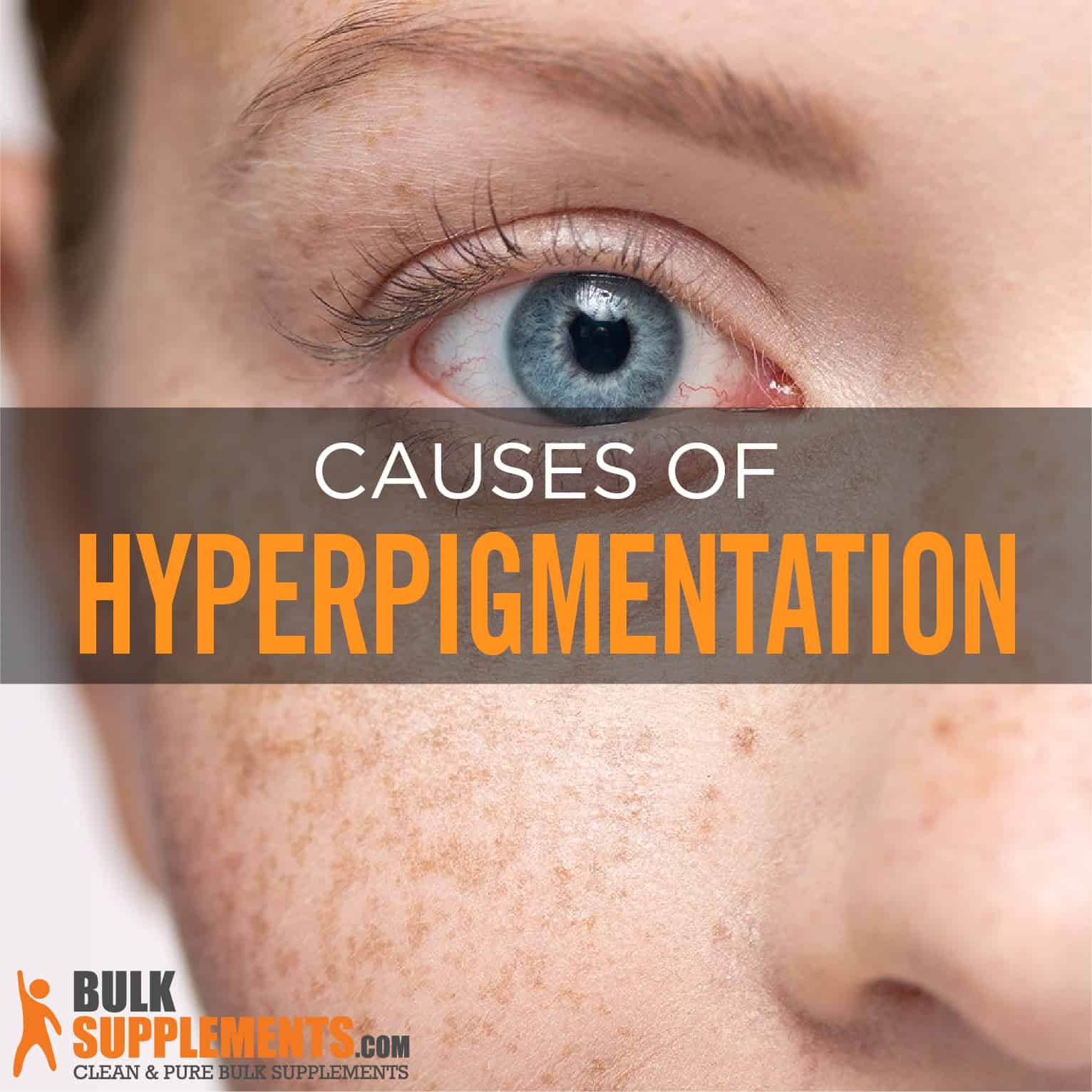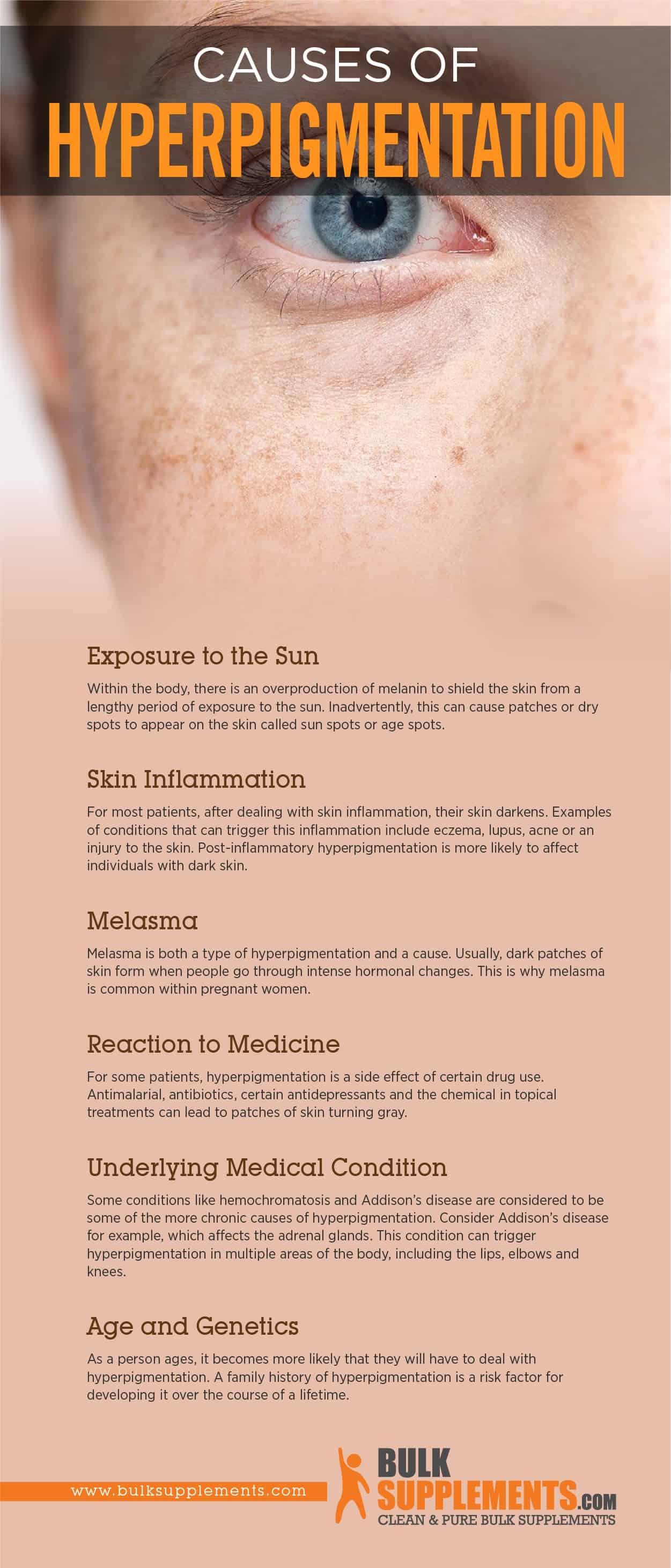Hyperpigmentation: Symptoms, Causes & Treatment
by James Denlinger Digital Marketing Strategist
What is Hyperpigmentation?
Hyperpigmentation occurs when more than the necessary amount of melanin (the pigment responsible for giving skin its color) is produced. This can cause the affected areas of the skin to look darker than the surrounding areas. Hyperpigmentation can affect anyone irrespective of gender, age or ethnicity.
There are multiple types of hyperpigmentation, some of which includes sun spots and melasma. These are more likely to affect the parts of the skin that are open to exposure from the sun like the arms, legs and face. Melasma is also responsible for causing hyperpigmentation around the mouth. Other forms of hyperpigmentation like acne hyperpigmentation occur after an injury or during recovery from skin inflammation like burns, cuts, lupus or acne. These could affect just about anywhere on the body.
In some cases, having extra pigment could be harmless. But in other cases, it could be an indicator of a more severe medical condition. It is also important to note that hyperpigmentation gets worse with age.
Melasma
Melasma is the most common form of hyperpigmentation. Known by the brown or tan patches it comes with, it affects mainly the face or areas exposed to sunlight. Melasma causes discoloration on the face, dark spots on the lips and is responsible for blotchy skin.
Melasma also affects pregnant women and is often called the mask of pregnancy. However, this condition can also affect men. If you are dealing with melasma, a good way to get rid of it would be to reduce your exposure to sunlight.
Periorbital hyperpigmentation refers to dark patches situated around the eye. This is another form of hyperpigmentation unique to individuals of Mediterranean lineage.
Causes of Hyperpigmentation
Depending on the type of hyperpigmentation a patient might be dealing with, the cause may differ. Here are some of the most common causes of hyperpigmentation:
Exposure to the Sun
Within the body, there is an overproduction of melanin to shield the skin from a lengthy period of exposure to the sun. Inadvertently, this can cause patches or dry spots to appear on the skin called sun spots or age spots.
Skin Inflammation
For most patients, after dealing with skin inflammation, their skin darkens. Examples of conditions that can trigger this inflammation include eczema, lupus, acne or an injury to the skin. Post-inflammatory hyperpigmentation is more likely to affect individuals with dark skin.
Melasma
Melasma is both a type of hyperpigmentation and a cause. Usually, dark patches of skin form when people go through intense hormonal changes. This is why melasma is common within pregnant women.
Reaction to Medicine
For some patients, hyperpigmentation is a side effect of certain drug use. Antimalarial, antibiotics, certain antidepressants and the chemical in topical treatments can lead to patches of skin turning gray.
Underlying Medical Condition
Some conditions like hemochromatosis and Addison’s disease are considered to be some of the more chronic causes of hyperpigmentation. Consider Addison’s disease for example, which affects the adrenal glands. This condition can trigger hyperpigmentation in multiple areas of the body, including the lips, elbows and knees.
Age and Genetics
As a person ages, it becomes more likely that they will have to deal with hyperpigmentation. A family history of hyperpigmentation is a risk factor for developing it over the course of a lifetime.

Melasma vs. Sun Spots
Melasma and sunspots are also known as solar lentigines, and are the most common types of hyperpigmentation. Melasma is believed to be caused by hormonal changes and it appears during pregnancy, while solar lentigines are related to an extended period of exposure to the sun. Melasma appears on the face and the abdomen while sun spots appear on the areas of the body that have been exposed to the sun like the face and hands.
Symptoms of Hyperpigmentation
The symptoms of hyperpigmentation depend on the type of hyperpigmentation one has. Here are the most common types of hyperpigmentation and their corresponding symptoms.
Melasma
Melasma is the most common form of hyperpigmentation and it frequents pregnant women. It affects parts of the face like the nose, cheeks, forehead or above the lips. Melasma is a bit difficult to deal with compared to the other types of hyperpigmentation.
Symptoms of Melasma
Patches on the skin, usually on the face and symmetrically aligned. These patches can also appear on the neck, chin, cheeks and bridge of the nose.
How to Diagnose Melasma
To diagnose melasma, your doctor would need to conduct a visual examination or make use of Wood’s lamp examination, which involves a light being held against your skin to check for a fungal or bacterial infection to ascertain the severity of melasma infection. In some severe cases, a skin biopsy is necessary.
Post-Inflammatory Hyperpigmentation
This type of hyperpigmentation emanates from trauma or skin ailments like eczema, psoriasis or intense acne. These skin ailments cause an increase in the production of pigments within the body causing dark spots to become visible.
Symptoms of Post-Inflammatory Hyperpigmentation
Patches of black or light brown usually show up on the area where the skin injury happened. The patches get darker when exposed to the sun. The pigments usually show up after the skin ailment or injury is healed.
How to Diagnose Post-Inflammatory Hyperpigmentation
Your doctor can diagnose this type of hyperpigmentation by reviewing your medical history, running skin examinations and doing a biopsy of the patch. It is important to note that this type of hyperpigmentation mainly affects individuals with a darker skin tone.
Sunspots or Solar Lentigines
Solar lentigines or sunspots are the third most common type of hyperpigmentation. It is caused by excessive exposure to sun rays. And in some cases, this condition could set in as a result of years of sunlight exposure.
Symptoms of Solar Lentigines
The spots caused by sunspots are usually light brown (also referred to as freckles). These tend to appear mainly on the face, chest, neck and hands — primarily areas with exposure to UV rays. This affects just about anyone, but it is more pronounced in individuals with light to medium skin tones. These freckles also get darker with continuous exposure to the sun.
How to Diagnose Sunspots or Solar Lentigines
To diagnose this condition, a visual examination of the skin is often enough for most professionals. However, some sunspots could be a symptom of an underlying issue like melanoma (a form of skin cancer). If that is the case, the doctor could choose to run more tests to pinpoint the severity of the condition.
Treatment for Hyperpigmentation
Hydroquinone
This particular substance has proven to be very effective in reducing the effects of hyperpigmentation (especially melasma) and goes a step further to prevent discoloration. In most cases, it is best to use substances with 2 percent hydroquinone.
Chemical Peels
Chemical peels have come to show a lot of potential in alleviating and even reversing the results of hyperpigmentation. They are also safe and effective in completely removing spots.
Kojic Acid
This is a nontoxic bleaching agent derived from palm oil, which provides amazing results regarding lightening dark spots and preventing greater discoloration brought on by surplus melanin production.
Supplements for Hyperpigmentation
Apart from the other forms of treatments, supplements can be a great way to manage your hyperpigmentation symptoms and possibly prevent a reoccurrence. With supplements, the ideal way to get the most out of them is to use them on a regular basis.
Biotin (Vitamin B7)
Well known in the beauty world, biotin plays a vital role in the health and growth of skin, nails and hair. Be very careful with pure biotin, though. Too much can cause serious side effects. Discuss with a doctor before adding this to your regimen.
L-Ascorbic Acid
This popular skin care ingredient helps in lightening hyperpigmentation spots. As a supplement, take about 1,000 mg (1/4 tsp) of L-ascorbic acid daily.
Vitamin B3 Niacinamide
B vitamins play a large role in overall health. Vitamin B3 stabilizes the skin’s pH levels and helps boost the skin’s protective barrier. As a dietary supplement, take 1 capsule daily, preferably with a meal.
Omega 3 Fatty Acids
Omega 3 fatty acids help to support overall health, as well as heart and bone strength. As a supplement, take 3 soft gels once or twice daily. It helps to reduce inflammation and oxidative damage while supporting skin elasticity and moisture.
Zinc
A natural antioxidant, zinc may support eye, bone and heart health. As a supplement, take 100 mg one to three times daily, or as directed by your doctor. For the most accurate measuring results, use a milligram scale.
Pure Glutathione
Glutathione houses anti-aging properties. The ideal serving size can range from as little as 50 mg per day to as much as 500 mg per day, depending on intended effect. A serving of a little less than 1/4 tsp should yield about 500 mg. To get the most from this supplement, it is advisable to eat before using it.
The Bottom Line
Hyperpigmentation may not be fatal, but it doesn’t mean it should be treated lightly. Depending on the severity of the conditions, you could choose to deal with the condition by purchasing some over the counter products or visiting your doctor for a consultation. If you notice other symptoms along with hyperpigmentation, you should seek out immediate advice from your doctor.
Sponsor Ads
Created on Mar 8th 2020 20:14. Viewed 397 times.



